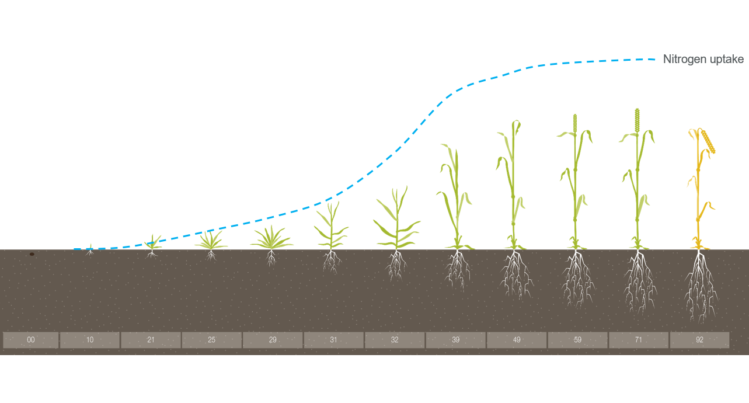
Fertilizer with enchanced efficiency (EEF) – smart solution for growing demand
Nitrogen application is always associated with considerable N-losses to the environment. The N uptake by plant is uneven and depends on growth development stage. At the beginning of a plant life only small quantities of N are taken up by plant, then the uptake increases significantly and reaches its maximum during mass growth stages and declines close to crop maturity.
If it would be possible to synchronize nutrient supply with the uptake pattern, it would mean an optimal plant nutrition, an increased nutrient use efficiency, high economic efficiency of fertilization and the minimization of unfavorable impacts on the environment. Though multiple application according to a plant current needs is not an effective solution, because it is more labor-intensive, very much dependent on weather, raises energy costs, leads to soil compaction and at the end does not allow to avoid considerable N-losses. The solution is to upgrade the fertilizer, to slow down the natural degradation processes and raise its efficiency.

NI, UI and SRF/CRF are options to approximate to the optimal fertilization where nutrient release is synchronized with plant uptake.
The market offers several enhanced efficiency fertilizer (EEF) technologies to better match the supply/availability of N with the uptake by crops. EEF are fertilizer products that allow to increase nutrient availability and reduce potential of nutrient losses to the environment e.g., gaseous losses, leaching or runoff, compared to an appropriate reference product. They can be categorized into stabilized and controlled-/slow-release fertilizers.
Controlled- (CRF) and slow-release fertilizers (SRF) aim at time-optimized release of nutrients according to the uptake patterns of the crop. CRF are conventional soluble fertilizers covered with protective polymer-coating, which controls water penetration through micro-pores and thus the fertilizer’s dissolution. One big issue of CRF with polymer-coating is the degradability of the coating substances in soil, contributing to micro plastic accumulation. As for SRF, for example in case of protective sulphur coating on urea, N release is made possible by microbial and hydrolytic degradation in the protective sulphur coating. At the same time, in this case, N release cannot be well controlled. For example, because the granules are not attrition-resistant, and cracks and imperfections of the sulphur coating can lead to a very quick release (“burst”) of the nitrogen after contact with water.
Stabilized fertilizers in their turn seem to be a smarter solution. With nitrification inhibitor (NI) or urease inhibitor (UI) they help to make the applied N longer available, as the normally incurring N losses are significantly limited, and therefore plants are nourished more efficiently. Both inhibitors have in common that they temporarily inhibit the enzymes responsible for nitrogen turnover processes (urea hydrolysis (UI) or the first step of nitrification (NI)) and thus protect N from volatilization, leaching or gaseous N2O emissions. As a result, N is longer available and supplies crops according to their natural needs.
The stabilized fertilizers can help us raise the efficiency of agricultural production and cover the needs of growing population, providing numerous agronomic, economic and environmental advantages, such as high efficiency in crop production, reduced application cost, reduced environmental effects, the need to improve crop yields and ease of application. Apart from this, the usage of the stabilized fertilizers allows to comply with the regulations and avoid penalties that encourage growers to minimize fertilizer effects on climate and environment.
Click to learn more about our EEF products UTEC®